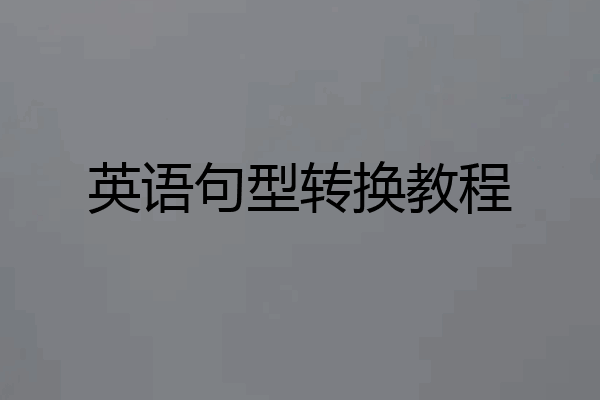
claire小雨
1、看清转换句型的要求。2、注意转换后句型的结构,如果是特殊疑问句,要把特殊疑问词前置后接一般疑问句的句序。如果是感叹句,要由what/how引导等等。3、注意转换后的细节,如单复数、词性的变化等。


azaarsenal
一.陈述句改否定句1,句子中有联系动词be或情态动词can ,may ,must或助动词will, have, had等词的,应在其后加not.*句中有some , already的,将其变为any, yet 如:There are some people in the garden.---There are not(或aren’t) any people in the garden. We have already learned English for three years. ---We have not (或haven’t) learned English for three years yet.*already变否定用yet,同时一般放句后。注意have是助动词,还是实义动词。如果是实义动词,要用助动词do的否定式。例:She has supper at six in the evening.---She does not have supper at six in the evening. 2,句子中的谓语动词为实义动词时,则在动词前加don’t(doesn’t, didn’t), 原来的动词恢复原形(分词除外)。这类句子经常考的谓语动词是have和do 。应掌握以下技巧:如:She does (did) her homework everyday(yesterday).----She doesn’t( didn’t) do her homework everyday (yesterday).注意:在上句中,原谓语动词(即,实意动词does)前加否定助动词doesn’t, 原谓语动词does 变为原形 doShe has (had) a meeting today (yesterday).----She doesn’t (didn’t) have a meeting today (yesterday). 注意:这里的has或 had 要变为原形have3,had better句型是考试的重点内容之一。它常与主语缩写,如you’d ,这种缩写只要看后面有没有better, 即为had, 切忌误认为wouldhad better句型意思为“最好-----, 还是----好”,常有告诫、劝告、催促之意,其后接不带to 的不定式,即动词原形。它的否定形式, 一定要把not放在better后面。*had better +动词原形------(肯定式)had better not +动词原形-----(否定式)如:You’d better catch a bus.你最好赶得上车子(赶快啊!)You’d better not take these seats.你还是不要做这些位置(座位)此句型的反义疑问句是:You’d better do it now, hadn’t you?二.祈使句改否定句在前面直接加Don’t,而不要管祈使句是以什么动词开始。如:Look out of the window.----Don’t look out of the window.考试中常出现以do, have, be开头的祈使句变为否定句。改写这样的句子,应在do (或have和 be) 前加助动词don’t, 切忌在do (have, be) 后面直接加not如:Do it after class.---Don’t do it after class.三.复合句改否定句1,复合句改否定句应掌握think、believe和 feel这三个主句谓语动词后接宾语从句时整个句子的否定形式。这类句子改为否定句时,要对上述主句谓语动词进行否定,但否定意思转移到后面的宾语从句。如:I think he will go there tomorrow.--- I don’t think he will go there tomorrow. 汉语的意思是“我想他明天不会去那里”,千万不要译“我不想他明天去那里”。更不要把英语句子改成 I think he won’t(*严重错误) go there tomorrow.大错特错。2,含有both词语的句子改否定句陈述句含有both+名词或者both of +名词或代词宾格作主语时,改写否定句要用neither 替代both,注意把谓语动词复数形式改写为单数形式。如:Both of them learn English in that school.------ Neither of them learns English in that school.句中含有 both A and B改否定句时,要将其改为 neither A nor B, 其谓语动词根据nor后面的名词的数做相应变化。both A and B——变否定—— neither A nor B如:Both Mary and Jim are students.----- Neither Mary nor Jim is a student.四.陈述句改写成一般疑问句除遵循be、 will、 情态动词(can、 may、 must)提前以及实义动词前加do (does, did) 以外,还要注意以下技巧:1.陈述句有some, something的,应改为any, anything 。*但是,some与其它词构成的固定搭配不要变化,如:do some shopping/ cooking/ listening/ washing/ reading等。例:There is some oil on the plate.----- Is there any oil on the plate?Alice does some reading every night.---- Does Alice do some reading every night?2,陈述句主语为第三人称单数 时,且谓语动词是has 或had(不表示“有”的含义,而属其它含义时),或者谓语动词是does或did (表示“做,干”的含义),则句前需要加助动词does (did) 构成一般疑问句,并且实义动词应变为原形 have、do 或者其他动词原形 。如:He usually has lunch at 11:30.----- Does he usually have lunch at 11:30 ?Mary sang a beautiful song in the last party.---- Did Mary sing the beautiful song in the last party?五.改写成特殊疑问句。特殊疑问句由“疑问句 + 一般疑问句”构成,改写这种句子应把握两个关键,一是选准疑问词;二是将疑问词后的句子变成一般疑问句。注意以下技巧:1. 对于时间划线用what time ——(具体时间,如at 9:00)how long ——(一段时间,如since 2000, for two days) how often——( 频率时间,如once a year) how soon——( 将来时间,如in a month)。如:We have lived here since 1986.-----How long have you lived here?2, 对于职业划线用what.如:Henry is an English teacher.-----What is Henry?3, 对距离划线用how far,对长度划线用how long,注意二者不能互换。如:He travelled nearly ten thousand kilometers. ----How far did he travel ?The Yellow River is 5464 kilometres long. -----How long is the Yellow River?4, 对数量划线用how many (后面跟可数名词复数),how much(后面可跟不可数名词,也可单独作句子成份)如:There are four persons in our office.----How many persons are there in your office?This book is six dollars.-----How much is this book?5, 对其它部分划线的见以下的例子:对日期提问:It’s December 31 today.----What’s the date today?对颜色提问:The tree is green.----What colour is the tree?对年龄提问:My nephew is about four.----How old is your nephew?对姓名提问:My name is Helen.----What’s your name?对事物、事情提问:They are going to visit the Great wall next week.----What are they going to do next week?对班级提问:We’re in Class One, Grade Three.----What class(grade) are you in?——或Which class(或grade) are you in ?对重量提问:I want a kilo of meat.----How much meat do you want?对地点提问:He works in a school.----Where does he work?对星期提问:It’s Wednesday today.----What day is it today?对方式提问:I usually come to school on foot.----How do you usually come to school?对原因提问:My face turned red because I told my teacher a lie.---Why did your face turn red?六.改写成反意疑问句。反意疑问句由“陈述句 + 简略问句”构成,当陈述句为肯定句时,简略问句为否定形式,反之亦然。关键抓住三点:1)是简略问句的动词应与陈述句的动词相对应,并采用一般疑问句的助动词或情态动词的形式2)是简略问句的主语一般用代词,不再重复陈述句的名词3)是陈述句中如存在某些具有否定意义的词( hardly, few、little、seldom…等),简略问句应为肯定形式。这是改写反意疑问句的一般技巧。另外除需熟悉一般情况外,更应掌握特殊情况。特殊情况 :简单句的附加简略问句1)陈述句部分为there be结构,附加的简略问句为be (not) there?例:There are not any people living here , is there? 绝不能因为any people为主语而用are they等。2)陈述句为I am ,附加的简略问句为aren’t I .例:I’ m taller than you, aren’t I. 不能用am not I .这是特殊用法。3)陈述句主语为everybody , everyone , somebody ,someone , nobody , no one , none等时,附加简略问句的主语用be和they例:Nobody was looking for me, were they .如果陈述句中有nobody, no one, none时,附加简略问句要用肯定形式。4)陈述中的主语为everything ,something ,anything ,nothing时,附加的简略问句主语用be和it .例:Everything is ready for the party, isn’t it?七.改写成感叹句1陈述句改感叹句感叹句的基本句型结构有两种,即:How + 形容词或副词 + (主语 + 谓语) !What + a(或an) + 形容词 + 单、复数名词 + (主语 + 谓语) ! *注:a(或an) + 形容词,这部分可省。 感叹句中的主语和谓语可省略,但不可以颠倒顺序。关键就在于看句中词性之间的关系。总的原则是:what(后接名词)how(后接形容词或副词)改写感叹句时首先对被改写的陈述句进行分析若是副词修饰谓语动词(则用how 改写)。如:He works hard .(副词hard修饰谓语动词works,故用how改写)----How hard he works!若句中有形容词,要看形容词是作表语(就用how改写),还是作定语修饰名词(就用what改写)。如:The Chinese tea tastes nice .(nice是表语,故该用how改写)-----How nice the Chinese tea tastes! Jenny is a beautiful girl . (名词短语a beautiful girl,故用what改写)——What a beautiful girl Jenny is .记住,选用what a (an) 时后接的名词应为可数名词单数,若后接不可数名词只能用what改写。还要观察形容词是否修饰名词,也可以观察名词后有无谓语,如果没有谓语,则应选用what或what a (an), 如果有谓语则选用how